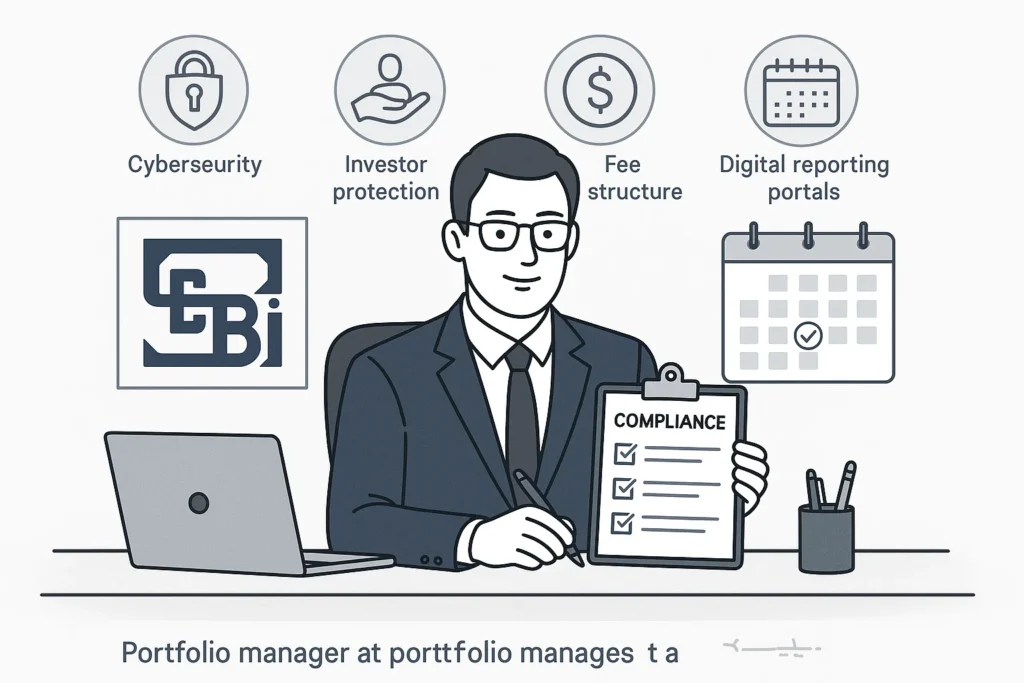SEBI Master Circular for Portfolio Managers 2025: What Has Changed?
SEBI has issued a new Master Circular for Portfolio Managers (SEBI/HO/IMD/IMD-POD-1/P/CIR/2025/104) dated July 17, 2025. This circular consolidates all existing guidelines up to March 31, 2025, into one comprehensive regulatory framework. It aims to simplify compliance, enhance transparency, and ensure stronger investor protection across India’s growing portfolio management industry.
Let’s break down what’s new, what’s changed, and what portfolio managers and investors should prepare for.
Why This Master Circular Matters
Portfolio Managers (PMs) manage high-value investments for HNIs, institutions, and family offices. Over the years, SEBI issued multiple circulars to regulate their functioning. However, these were scattered, making compliance cumbersome.
To address this, SEBI has:
- Superseded 39 old circulars, removing overlaps and inconsistencies.
- Consolidated all operational, disclosure, and compliance requirements in one place.
- Introduced stricter reporting timelines, fee transparency norms, and cybersecurity mandates.
This new circular acts as a rulebook for all SEBI-registered portfolio managers and marks a regulatory shift toward greater standardisation and automation.
1. Circular Overview and Applicability
- Title: Master Circular for Portfolio Managers
- Issued by: SEBI, Investment Management Department
- Date of Release: July 17, 2025
- Effective from: Immediate for most operational submissions
- Legal Authority: Under Section 11(1) of the SEBI Act, 1992
The circular will serve as the primary reference for all compliance and procedural matters going forward.
2. Rescission of 39 Previous Circulars
SEBI has formally rescinded 39 earlier circulars. These covered a range of topics including:
- Investment restrictions
- Advertisements and performance disclosures
- Client onboarding procedures
- Net worth requirements
- Complaint redressal formats
- Fee governance norms
By doing so, SEBI has removed duplication, simplified compliance, and given portfolio managers a single point of reference.
3. Enhanced Reporting and Disclosures
SEBI’s Master Circular mandates granular data disclosures through structured formats:
| Report Type | Frequency | Format (Annexure) |
|---|---|---|
| Monthly Portfolio Activity Report | Monthly | Annexure 5A |
| Client-wise AUM, Transactions & Holdings | Monthly | Annexures 5B & 5C |
| Quarterly Client Disclosures | Quarterly | Annexure 5D |
| Complaints Disclosure Report | Monthly | Annexure 7A |
These must be submitted via SEBI’s Intermediary Portal within defined deadlines.
4. Investment Restrictions & Exposure Norms
One of the biggest changes is a 30% cap on investments in securities of associate or related parties per client AUM. This rule reduces conflict of interest and ensures portfolio managers act in the best interests of their clients.
To enforce this:
- PMs must obtain revised client consent (Annexure 3A).
- Disclosure must be made in the quarterly statement, including reasons for any passive breaches.
This step was long awaited by market watchers and is seen as a positive investor-first reform.
5. Returns Benchmarking Made Uniform
Performance measurement is now more standardised:
- Use of TWRR (Time-Weighted Rate of Return) is mandatory for strategy-level returns.
- Client-level returns must be disclosed using XIRR (Extended Internal Rate of Return).
- Portfolio Managers must benchmark returns against SEBI-approved strategy benchmarks for greater transparency.
This move will help clients better compare different PMS providers.
6. Cybersecurity Mandate
All portfolio managers must now align with SEBI’s Cybersecurity & Cyber Resilience Framework (CSCRF). This includes:
- Incident detection and reporting mechanisms
- Periodic vulnerability assessments
- Data backup policies
- Business continuity procedures
Given the growing digital nature of portfolio services, this ensures client data and funds are protected.
7. Custody & Fund Segregation
The circular introduces mandatory daily reconciliation of client funds and securities.
Portfolio managers must:
- Maintain separate accounts for each client
- Avoid co-mingling of funds
- Segregate proprietary investments from client portfolios
This provision boosts investor trust and aligns with international best practices.
8. Fee Governance & High Watermark Rule
To make fee structures more transparent:
- Portfolio Managers must adopt the High Watermark Principle, which ensures they charge clients only once for actual gains.
- At the time of onboarding, they must share a multi-scenario fee calculation example (Annexure 4A) with each client.
- They must disclose any deviation from the agreed fee structure in the quarterly reports.
This will make it harder for portfolio managers to charge hidden or unfair fees.
9. Distributor Oversight & Commission Norms
SEBI has tightened norms around PMS distributors:
- All PMS distributors must register with APMI (Association of Portfolio Managers in India).
- PMS providers can only pay trail commissions, no upfront fees.
- Distributor details must be disclosed in the client agreement.
These steps aim to reduce mis-selling and improve accountability in PMS distribution.
10. Implementation Timeline
Some changes are effective immediately, while others have staggered timelines:
| Requirement | Effective From |
|---|---|
| Monthly/quarterly reports via SEBI portal | Immediate |
| Cybersecurity compliance (CSCRF) | Immediate |
| Adoption of Compliance Monitoring Module (CMM) | Q1 FY26 (First by July 31) |
| Automated fund/security systems for PMs with AUM > ₹1,000 Cr | Within 6 months of breach |
11. Impact on Portfolio Managers
Here’s how the new circular reshapes the PMS landscape:
- Higher operational cost due to automation, reporting, and cybersecurity requirements.
- Greater scrutiny on fee models and investment decisions.
- Shift toward compliance-first approach, especially among large PMS players.
Smaller firms may need to invest in tech and regulatory advisory services to stay compliant. However, this will likely improve the credibility of the PMS industry as a whole.
12. What Investors Should Know
If you’re an existing or potential PMS investor, here’s what this means for you:
- Better transparency on portfolio returns, fees, and related-party investments
- Increased protection from mis-selling and conflict of interest
- More trust in the PMS ecosystem due to regulatory oversight
Make sure your PMS provider shares the updated fee sheet, consent forms, and quarterly disclosures as per the new format.
Final Thoughts on SEBI Master Circular for Portfolio Managers
The SEBI Portfolio Manager Master Circular 2025 is a milestone move that simplifies the regulatory maze, increases operational consistency, and prioritizes investor interest. While it imposes higher reporting and control costs for PMS providers, it lays the foundation for stronger governance and professionalisation of the industry.
As PMS AUM grows in India, SEBI’s firm grip on the industry ensures it evolves with discipline, efficiency, and fairness.
FAQs for SEBI Master Circular for Portfolio Managers
What is SEBI’s Master Circular for Portfolio Managers 2025?
It is a consolidated regulatory framework issued by SEBI for all portfolio managers to ensure consistent compliance and investor protection.
When was the latest SEBI Master Circular released?
The updated circular was released in July 2025, replacing the previous June 2024 version.
What are the major changes in the 2025 Master Circular?
Key changes include revised fee structures, enhanced disclosure norms, cybersecurity compliance, and standardized client reporting.
How many old circulars has SEBI rescinded?
SEBI rescinded 39 previous circulars to reduce redundancy and promote clarity.
What is the High Watermark Principle under the new SEBI circular?
It ensures that portfolio managers can charge performance fees only on gains exceeding the previous highest portfolio value.
What are the new reporting requirements for portfolio managers?
Managers must submit monthly and quarterly data on AUM, holdings, fees, and complaints via SEBI’s Intermediary Portal.
What is Annexure 4A in the SEBI circular?
Annexure 4A provides a mandatory fee calculation example that portfolio managers must share at client onboarding.
Are there any cybersecurity norms in the circular?
Yes, managers must now comply with SEBI’s Cybersecurity & Cyber Resilience Framework (CSCRF).
What is the compliance deadline for the new rules?
Submissions begin immediately; CMM adoption starts from Q1 FY26, and large PMs must implement automated fund management within six months of breaching ₹1,000 crore AUM.
Where can I read the full SEBI Master Circular for Portfolio Managers?
The full circular is available on SEBI’s website here.
Related Articles
Best Ad Tech Stock: India’s Emerging Digital Goldmine for Investors
NABFID Infrastructure Lending Stocks: Impact on Infra Companies & Market Outlook
Retail Inflation Crashes to 2.10% in June 2025: What It Means for Consumers, RBI & Stocks




